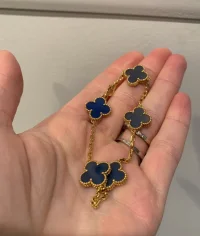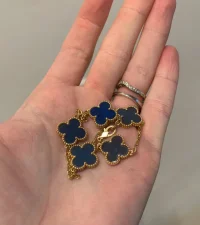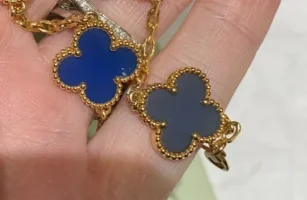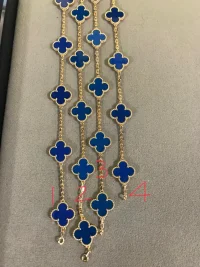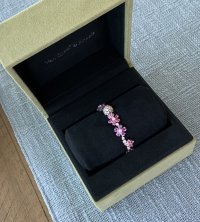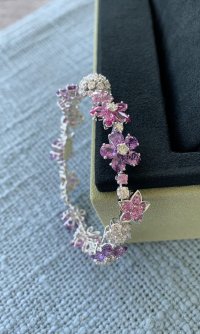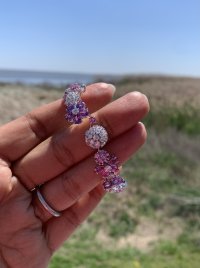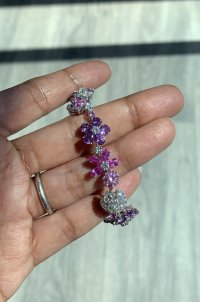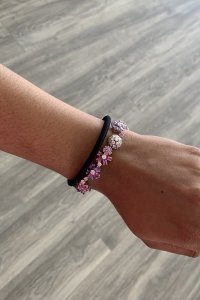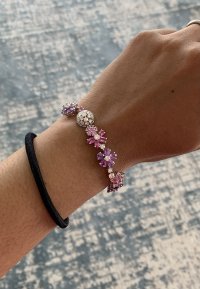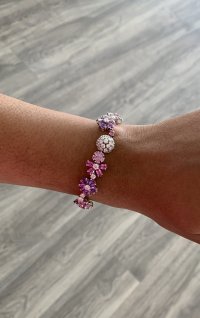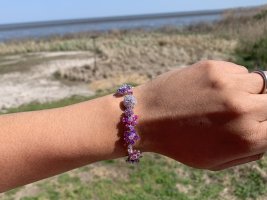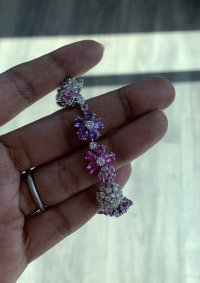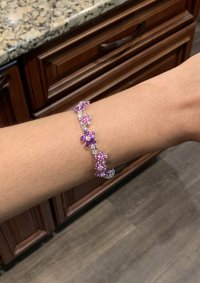I have five pieces of blue agate, but they all look like brand new. Of course, I have worn them sparingly. I think I may have gotten them wet, but not exposed to chemicals. Imagine my shock when I saw the bracelet of a friend, I am guessing it was exposed to heat or chemicals. You can see that the color of some of the motives have changed so they clearly do not match.
You are using an out of date browser. It may not display this or other websites correctly.
You should upgrade or use an alternative browser.
You should upgrade or use an alternative browser.
Blue Agate Fading?
- Thread starter lynne_ross
- Start date
TPF may earn a commission from merchant affiliate
links, including eBay, Amazon, and others
More options
Who Replied?Now that you mentioned it and have the photos side by side I did notice that the stones on my BA bracelet are also less uniform recently. I couldn’t be sure if it was always like that but I feel like I would’ve noticed during the purchase so this is comforting in the sense that it’s not only happening with mine. I probably won’t be replacing the stones for a long time either. But your lapis is everything!!I am convinced my BA has discoloured significantly. It was closer to my lapis years ago and the motifs were all similar colour. Now some of the motifs have turned a grey colour. It is still a beautiful piece and my necklace is sentimental so I will not replace stones unless they break. Here is a pic from when I recently cleaned my jewellery to show the mismatched bracelet stones.
I learned so much!!! Thank you for this informative post! I didn’t know the stones were dyed but it makes sense that it would not be able to withstand UV exposure over time. I wonder if re-dyeing is possible or if they would just toss your old stones and replace with new ones.
we have to remember that blue agate, as VCA calls it, is a dyed stone, i.e. agate doesn't really come in that bright shade of blue. the real "blue" agate is what VCA calls "Chalcedony" which, in standard gemology or in the trade is more commonly called blue lace agate. that one is the undyed version of agate.
blue lace agate:
View attachment 6160145
here's what natural agate typically looks like. note the milky tones, banding, and muted colors:
View attachment 6160144
side note: what VCA calls "carnelian" is not really true carnelian but agate dyed red. it is difficult to find carnelian stones that vivid shade of red, although such stones do occur, because ordinary carnelian is typically a milky orange with a lot of banding. moreover, true red carnelian is often included, i.e. has many "impurities", and doesn't resemble the very clean or very bright red stones VCA tends to use.
sample of true red carnelian where you can see inclusions that appear as "veins":
View attachment 6160143
ordinary or common carnelian:
View attachment 6160146
anyway.
dyeing agate stones is an acceptable and longstanding gemstone treatment. it has been around since ancient Egyptian times, and then continued with the Greeks and Romans, and then the present times. the basic process is as follows:
dyed agate is susceptible to fading, especially when:
- agate is boiled in a sugar solution (like honey or molasses) to open up the pores
- then it’s treated with iron salts or aniline dyes to achieve a blue color
- aniline dyes are used since they are not UV-stable and can fade over time if exposed to direct sunlight
- even some mineral-based dyes may degrade with prolonged UV exposure.
hope this little gemology detour was useful. open to questions or nerding out more if anyone’s interested
trivia: VCA used to offer green agate in the 70's
this pic is from 1973:
View attachment 6160149
View attachment 6160150
I’m instantly regretting that I showered with my BA bracelet quite a few times which probably resulted in the colors fading over the years. These photos have convinced me to stop doing that lolI have five pieces of blue agate, but they all look like brand new. Of course, I have worn them sparingly. I think I may have gotten them wet, but not exposed to chemicals. Imagine my shock when I saw the bracelet of a friend, I am guessing it was exposed to heat or chemicals. You can see that the color of some of the motives have changed so they clearly do not match.
This is good stuff to know. Thank you for sharing @nicole0612I have five pieces of blue agate, but they all look like brand new. Of course, I have worn them sparingly. I think I may have gotten them wet, but not exposed to chemicals. Imagine my shock when I saw the bracelet of a friend, I am guessing it was exposed to heat or chemicals. You can see that the color of some of the motives have changed so they clearly do not match.
Last edited:
Is yours faded too? Hopefully not!I’m instantly regretting that I showered with my BA bracelet quite a few times which probably resulted in the colors fading over the years. These photos have convinced me to stop doing that lol
I do appreciate that VCA takes the time to source matching stones for their HJ pieces as they should given the price tags, but I do wonder why they’ve recently been slacking on their regular Alhambra pieces since I’ve been seeing more mismatched motifs on display at the boutique. I know the brand had a sudden uptick in interest and sales these last few years and they were trying to catch up to the demand but it is a bit disappointing that they don’t give the same treatment to their “entry level” pieces even though they are still very spendy for most people!thanks for that. honestly, I really appreciate the open-mindedness. and yes, sourcing untreated sapphires in specific colors is incredibly difficult, especially when you want them to match across a piece. that kind of thing takes time, which is why I always say: VCA really doesn't take shortcuts when it comes to visual harmony (I hear they also find it challenging to match the ruby version of Folie des Prés bracelet; also takes a lot of time)
just to share where I’m coming from: even though VCA uses dyed agate and stabilized turquoise, and they don’t always specify whether their gemstones are heated or unheated on their print materials (they're selling romance, poetry, and timeless beauty after all), that doesn’t take away from my love for the maison. it doesn’t lessen my enjoyment of their pieces, and I genuinely look forward to being their customer for years to come

Also given that their BA and Carnelian are most likely dyed I wonder why they haven’t been able to achieve more consistency with the dye color to be more vibrant. Most of the BA pieces I’ve seen at the boutique look dull and yellowish even though they are brand new. It’s been hard to find vibrant BA like the ones I saw from 4 years ago.
I will have to take a closer look later and post photos but the last time I wore them I noticed the motifs were less uniform in color compared to when I first got them in 2021. I had bursts of wearing them 24/7 for a while (though not in the pool or ocean but definitely showered with them on) but the last 2 years I only wore them to go out and took off when at home.Is yours faded too? Hopefully not!
Lighting does make a huge impact on how the stones appear since it shifts color that way but my bracelet was definitely quite uniform when I first got them otherwise I would have selected a different one.
Oh no! I am so sad to see this. I purchased a blue agate necklace in November and I've been wearing it almost nonstop since then. I do take it off to shower but I sleep in it and wear it all day. I just love it, it makes me happy to wear but I wouldnt be happy if that happened to itI have five pieces of blue agate, but they all look like brand new. Of course, I have worn them sparingly. I think I may have gotten them wet, but not exposed to chemicals. Imagine my shock when I saw the bracelet of a friend, I am guessing it was exposed to heat or chemicals. You can see that the color of some of the motives have changed so they clearly do not match.
I think this is an unexpected outcome, but I wanted to add to the collected information here. I have blue agate pieces from the original launch, about six years old now, and they look exactly like new. I have only worn my bracelets to lengthen my necklace, so I would guess that bracelets worn on the wrist generally get more exposure to whatever is causing this discoloration.Oh no! I am so sad to see this. I purchased a blue agate necklace in November and I've been wearing it almost nonstop since then. I do take it off to shower but I sleep in it and wear it all day. I just love it, it makes me happy to wear but I wouldnt be happy if that happened to it
that’s amazing to hear, and it actually supports what I was saying. since Folie des Prés is part of VCA’s high jewelry offering, it makes total sense that they’d go the extra mile to source unheated sapphires, especially in delicate shades like pink and lavender. waiting 18 months to find matching stones really shows the level of care and commitment to visual harmony
it’s a perfect example of how VCA doesn’t follow a blanket approach to treatments but instead chooses what best serves the piece. when unheated stones can be used without compromising the design, they absolutely will
thanks again for sharing that, it's such a great real-world case
I understand the pain of matching pink sapphires firsthand. I have a wedding band that was gifted by a jeweler and it has mismatched pink sapphire stones / different colors! The ring came as a surprise (gift), and the jeweler told me they were unheated. I do appreciate her gift (she is sweet and most likely happily retired now), and now I’m reading this, I can see these pink sapphires stones are really hard to match in color if they are unheated. At the time, I did find it weird the colors were uneven if you look closely. Lol
Truly appreciate people sharing their experiences here. So far I see reports of color change on blue agate and carnelians, I wonder if anyone experienced color change on chalcedony creations? Since chalcedony is lighter in color, won’t that make chalcedony more susceptible to color change?
I just texted her and she confirmed her Folie bracelet is not treated, not even heat treated. She has the pink and lavender sapphire version. It took them a while to find all the matching stones. I think she waited 18 months.
Another confirmation that the sapphires in the Folie de pres collection are unheated (the blue version). The attention to detail is incredible. I should have not been surprised but was still impressed that the different hues and tones of a piece in 2023 matched perfectly to a piece from 2019.thanks for that. honestly, I really appreciate the open-mindedness. and yes, sourcing untreated sapphires in specific colors is incredibly difficult, especially when you want them to match across a piece. that kind of thing takes time, which is why I always say: VCA really doesn't take shortcuts when it comes to visual harmony (I hear they also find it challenging to match the ruby version of Folie des Prés bracelet; also takes a lot of time)
just to share where I’m coming from: even though VCA uses dyed agate and stabilized turquoise, and they don’t always specify whether their gemstones are heated or unheated on their print materials (they're selling romance, poetry, and timeless beauty after all), that doesn’t take away from my love for the maison. it doesn’t lessen my enjoyment of their pieces, and I genuinely look forward to being their customer for years to come

Thank you @allanrvj for the educational posts and everyone else as well, this has been an informative and engaging thread.
I guess this is an example of well matched purple sapphires.
- EpiFanatic
- Replies: 16
- Forum: Van Cleef & Arpels
Last edited:
Register on TPF! This sidebar then disappears and there are less ads!

